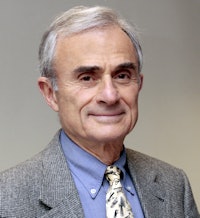Combined CT scans of the thorax -- which Medicare has been keeping an eye on -- aren't being overused after all. In fact, use of the combined scans is low and falling over time, according to a new study in the Journal of the American College of Radiology.
Dr. David C. Levin and colleagues from Thomas Jefferson University found that utilization of the combined scans did rise between 2001 and 2006, but it began to decline after 2007, falling by more than 10% through 2011.
"It was pretty low to begin with, but then it dropped substantially even below that point," said Levin, professor and chairman emeritus of radiology, in a phone interview with AuntMinnie.com.
Thoracic CT can be performed with or without contrast; in combined scans, it is performed first without contrast followed by the scan with contrast, the authors explained in the article. Multiphase exams deliver an additional dose of radiation, and most radiologists believe they should be used very infrequently, such as in cases of suspected aortic dissection or indeterminate lung nodules.
 Dr. David C. Levin.
Dr. David C. Levin.Most patients can be properly evaluated using single-phase scans, either with or without contrast, according to Levin and colleagues (JACR, August 2014, Vol. 11:8, pp. 788-790).
"Even for pulmonary nodules, nowadays most people are not using dual-phase scans -- they're just doing CT thorax without contrast," Levin said. "You could pick up a pulmonary nodule on either kind of CT scan for doing follow-up, which is fairly common, and most people are doing it using unenhanced CT scans."
Concerns about overuse also stem from the fact that the dual-phase scan is reimbursed at a higher rate than either single-phase scan, providing a potential incentive to use a combined scan improperly.
"If you're just looking at it from the business perspective, radiologists are better off doing a dual-phase scan because they get more for it, and yet what we've seen is that it dropped quite a bit from 2006 to 2011," Levin said. "So this goes against the business interests of radiologists."
A June 17, 2011, report in the New York Times said that use of the combined scans, based on 2008 Medicare data, was suspiciously high. According to the article, more than 200 hospitals across the U.S. used combined scans in about a third of their Medicare outpatients, and the U.S. Centers for Medicare and Medicaid Services (CMS) spent approximately $25 million on the combined scans in 2008.
"The article did not cast hospital imaging facilities in a very favorable light," Levin and colleagues wrote. "The obvious implication was, why did the responsible people allow this to happen?"
The authors decided to investigate the claims: Their study aimed to use the Medicare database to determine the extent of the scans and whether the utilization rate had risen or fallen in recent years.
Medicare data: 2001 to 2011
For data, Levin and colleagues turned to the Medicare Part B Physician/Supplier Procedure Summary Master Files for 2001 through 2011, choosing CPT codes for thoracic CT with contrast, without contrast, and both. They calculated utilization rates per 1,000 Medicare Advantage fee-for-service beneficiaries, as well as the percentage of combined scans among the total.
Global and professional components were included, but not technical component claims, which would have led to double-counting of combined exams, according to the researchers.
The results showed that utilization of combined scans rose from 2001 through 2006, peaking at 5.9 per 1,000 in 2006 and 2007. The rate then declined through 2011, reaching 3.8. For 2007 through 2011, the compound annual rate of change was -10.4%, the authors wrote.
In terms of global percentages, from 2001 through 2006, the combined CT scans totaled about 6% of all thoracic CT scans; however, the percentage declined progressively thereafter, reaching a low of 4.2% in 2011. There were no coding changes during the study period that might have confounded the results, according to Levin and colleagues.
Later results suggest the totals may have fallen even further. Based on the Hospital Compare website, the national average use of combined CT had fallen to 3.7% by December 2013. At Thomas Jefferson University Hospital, combined scans stood at 1.9% at the end of 2013, according to the authors.
"Despite the 2011 news report, only a very small percentage of thoracic CT scans nationwide are done both without and with contrast," they wrote. The fact that utilization dropped by almost one-third between 2006 and 2011 suggests that the practice is declining. The figure of 4.2% is a good benchmark against which to judge radiology facilities in the future, the group added.
There are several possible reasons for the positive news about declining use, but the likeliest one is radiologists learning about judicial use of the exams over time, according to Levin and colleagues.
"I think what happened was they did it because it was the right thing to do; people realized that doing dual-phase or combined scans is not necessary, it wastes money, it wastes radiation, and there's not really a good reason to do it in most instances," he said. In addition, referring physicians have become more aware of appropriateness criteria in recent years.
Finally, payors and radiology benefits managers have begun to exercise more comprehensive oversight, the authors wrote, adding that the existence of the Hospital Compare website may have created peer pressure to reduce the use of combined scans.
The Hospital Compare website isn't very easy to find, but it's worth looking for because information on this topic is highly relevant to hospitals assessing utilization, Levin said.
As for the New York Times article documenting heavy use of combined scans, it probably identified a real problem in some hospitals, but that situation is not the norm, and utilization rates are at appropriate levels now, the group concluded.
"I'm glad to see that radiologists are doing the right thing by reducing their use of the dual-phase or combined CT scans, because they should not be done except on rare occasions," Levin said.




















